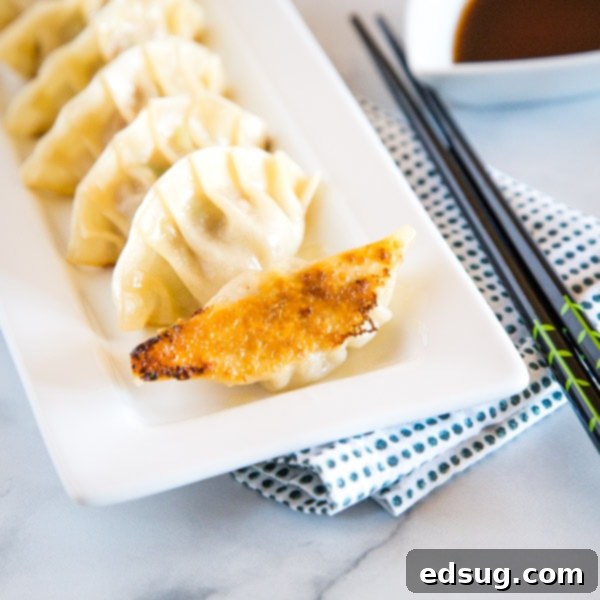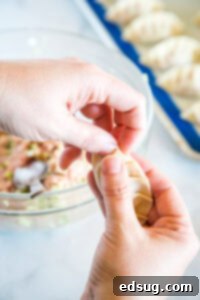Authentic Homemade Gyoza: Your Ultimate Guide to Perfect Japanese Pork Dumplings
Master the art of making Gyoza – delectable Japanese pan-fried dumplings bursting with savory ground pork and fresh vegetables, served with a simple yet irresistible dipping sauce. Perfect for a memorable family dinner and incredibly convenient to freeze for future enjoyment!
There’s nothing quite like the excitement of family travel, from selecting a dream destination to meticulously planning out sights, activities, and, of course, the culinary adventures that await. Our family eagerly participates in every step, and when it comes to favorite travel spots, Japan consistently tops our list!
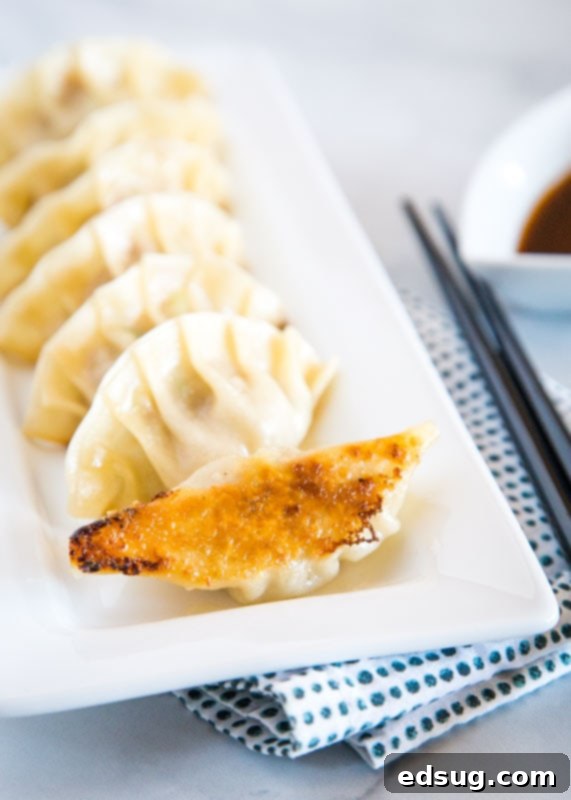
A significant part of our affection for Japan stems from its incredible food scene. While we often attempt to recreate these dishes at home, some require specific, hard-to-find ingredients that just aren’t readily available in the U.S. However, Gyoza is a glorious exception! You can absolutely craft authentic, restaurant-quality Japanese pork gyoza right in your own kitchen. Cooking international cuisine as a family is a fantastic way to introduce children to diverse cultures and countries, all while creating lasting memories and enjoying delicious meals together.
I am thrilled today to collaborate with the National Pork Board for their impactful Family Meals campaign. Having partnered with the Pork Board previously – you might recall my Oven Baked Pork Chops or Crispy Pork Cutlet recipes – our household genuinely consumes a lot of pork. In fact, one of the founding inspirations for this very website was to demonstrate how simple it can be for families to gather and share wholesome meals every single night.

The National Pork Board’s recent research, conducted over the last eight months of the pandemic when many families spent more time at home, revealed fascinating insights into the power of shared meals. Their findings indicate that family bonds are significantly strengthened through increased shared mealtimes, collaborative cooking, and simply spending more quality time together. Other compelling statistics from their research include:
- Over half of the families surveyed reported cooking more frequently in the past six months, with one in three actively trying new recipes.
- Even teenagers expressed enjoyment from connecting with family members during dinner.
- A remarkable 85% of families surveyed plan to continue their increased family meal habits even after the pandemic subsides.
Like many others, our travel plans were significantly disrupted in 2020. This led us to explore our kitchen more, experimenting with an ever-growing repertoire of global recipes. Gyoza quickly became a beloved family favorite we all enjoy making together. Whenever we’re in Japan, we seize every opportunity to order these delightful dumplings, and I can confidently say that this homemade recipe stands shoulder-to-shoulder with some of the best we’ve tasted abroad.
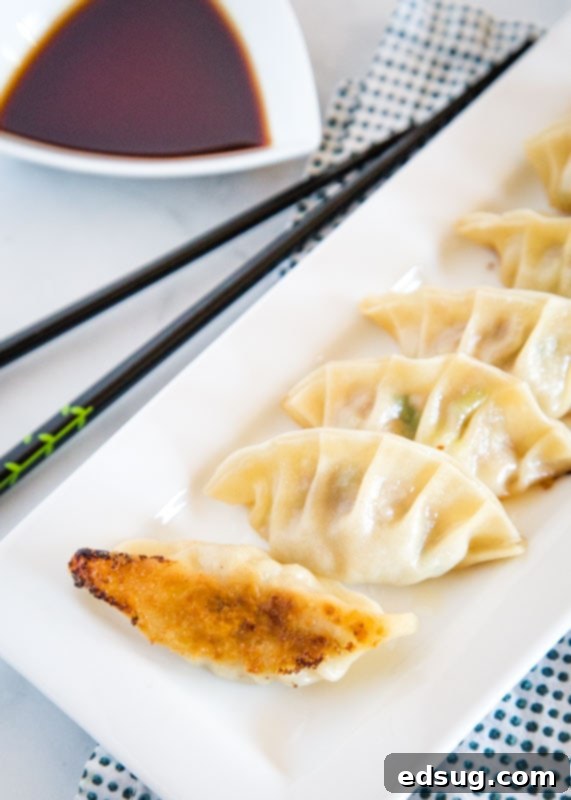
Spending quality time in the kitchen this past year, creating a diverse array of dishes, has been a true joy. And there’s one ingredient that consistently proves its versatility across almost every global cuisine: pork. Whether it’s crafting savory Pork Lo Mein from China, authentic Pork Adobo from the Philippines, or mouth-watering Carnitas from Mexico, pork offers endless delicious possibilities to explore and experience different cultures through food. Our gyoza recipe is no exception, showcasing pork’s ability to shine in Japanese cuisine.
What Exactly is Gyoza?
Gyoza are the Japanese rendition of Chinese dumplings, known for their distinctive pan-fried and then steamed preparation. They are typically filled with a delightful mixture of ground pork and finely chopped vegetables.
The magic of Japanese gyoza lies in their unique cooking method. First, they are pan-fried in a skillet with a small amount of oil until their bottoms achieve a beautiful, crispy golden-brown. This crucial step provides a delightful textural contrast. Next, water is added to the pan, and the gyoza are covered and steamed. This process cooks the filling thoroughly, rendering the pork exceptionally tender and juicy. Finally, a touch of sesame oil is often drizzled in, ensuring the bottoms regain their exquisite crispness just before serving, making each bite a symphony of textures and flavors.
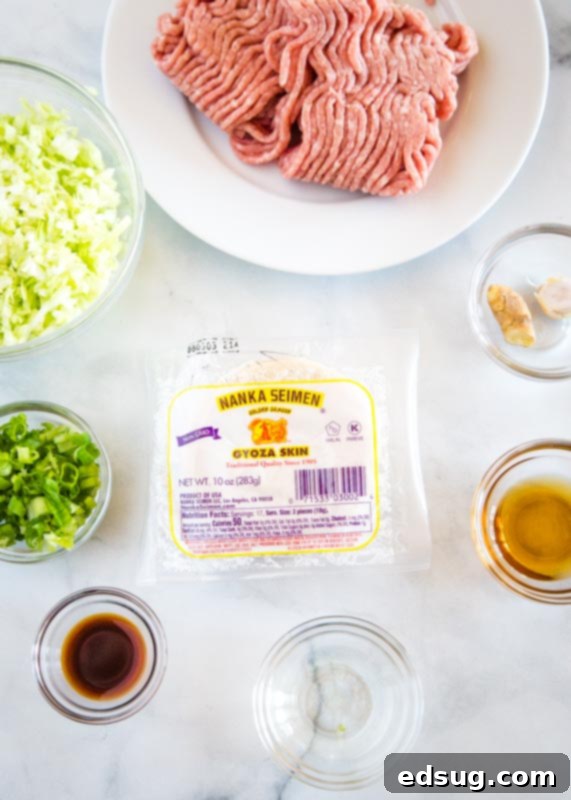
Essential Ingredients for Delicious Pork Gyoza
Crafting the perfect pork gyoza requires a thoughtful selection of fresh ingredients. Here’s a detailed look at what you’ll need and some helpful tips for each:
- Ground Pork: This forms the succulent base of our gyoza filling. Opt for good quality ground pork, readily available at most grocery stores. There’s no need to pre-cook it; the pork will cook beautifully and remain wonderfully juicy as the dumplings steam. For best flavor, a pork with a little fat content (e.g., 80/20) works well.
- Cabbage: While traditional Chinese dumplings often feature Napa cabbage, regular American green cabbage works perfectly and is easier to find. The key is to chop it very finely. This ensures the cabbage becomes incredibly tender and “melts” into the meat mixture during cooking, rather than remaining tough or crunchy.
- Garlic: Freshly minced garlic adds an indispensable aromatic depth to the filling. Don’t skimp on flavor here!
- Ginger: Fresh ginger, finely minced, provides that signature warming, zesty kick that is characteristic of authentic Asian dumplings.
- Green Onion: Adds a mild oniony flavor and a touch of freshness that brightens the entire filling.
- Soy Sauce: A foundational seasoning, adding umami and saltiness. Use a good quality soy sauce for the best flavor.
- Sesame Oil: Both in the filling and as a finishing drizzle, sesame oil imparts a distinct nutty aroma and flavor crucial to gyoza’s profile.
- Sake: Just a tablespoon of sake enhances the filling’s flavor and helps tenderize the pork. Culinary sake can often be found in Asian markets or even some larger grocery stores. If sake isn’t available, dry sherry is a suitable substitute. Alternatively, a mixture of 1 teaspoon rice wine vinegar and 2 teaspoons water can be used in a pinch.
- Gyoza Wrappers: These thin, round wrappers are specifically designed for gyoza, often found in the frozen section of Asian markets. They are typically thinner than standard Chinese dumpling wrappers, which contributes to gyoza’s delicate texture. If gyoza wrappers are unavailable, regular Chinese dumpling wrappers will work; you might just need to add an extra minute or two to the steaming time to ensure they cook through.
- Vegetable Oil: For pan-frying the gyoza to achieve that coveted crispy bottom.
- Salt & Pepper: Basic seasonings to balance and enhance all the flavors in the filling.
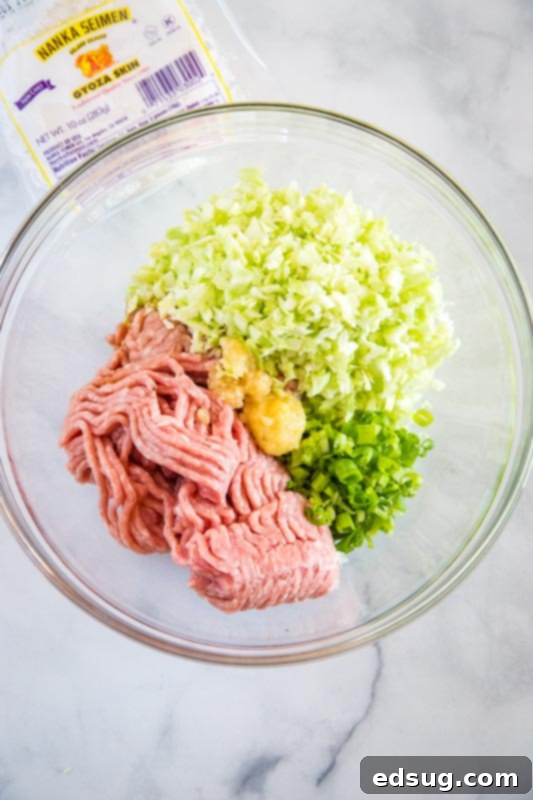
How to Store and Freeze Gyoza for Later
One of the most appealing aspects of making homemade gyoza is the ability to prepare a large batch and freeze them for later. While the actual process of making the filling and cooking the gyoza is straightforward, the folding can be time-consuming. Freezing them uncooked means you can enjoy the fruits of your labor many times over with minimal effort on busy weeknights!
To freeze gyoza effectively, follow these steps:
- After you’ve filled and skillfully folded all your pork gyoza, arrange them in a single layer on a baking sheet lined with parchment paper. Ensure they are not touching each other to prevent sticking.
- Cover the entire baking sheet tightly with plastic wrap to prevent freezer burn and odor absorption.
- Place the baking sheet in the freezer for a couple of hours, or until the gyoza are completely frozen solid. This “flash freezing” technique ensures they hold their shape and don’t clump together.
- Once solid, transfer the frozen gyoza from the baking sheet into a freezer-safe, airtight storage bag or container. Label with the date. They can be stored in the freezer for up to 2-3 months without a significant loss in quality.
Cooking frozen gyoza is incredibly simple! You follow the exact same cooking instructions as for fresh gyoza, but you’ll need to increase the steaming time by just a few minutes (typically 2-4 minutes longer). This makes for an incredibly convenient and delicious meal any time you crave them!

The Perfect Gyoza Dipping Sauce
A flavorful dipping sauce is absolutely essential for enhancing the taste of gyoza, and luckily, it couldn’t be simpler to prepare. Our go-to sauce is a straightforward yet perfectly balanced mix of rice vinegar and soy sauce. The tanginess of the vinegar beautifully cuts through the richness of the pork, while the soy sauce adds depth and umami.
For those who enjoy a bit of heat, in Japan, it’s common to find spicy chili oil on the table. You can easily stir a dash of chili oil into your sauce for an extra kick. Other popular additions include a small amount of grated fresh ginger, minced garlic, or a sprinkle of toasted sesame seeds for added texture and flavor complexity. Experiment to find your favorite combination!
Mastering the Art of Folding Gyoza
The beautifully pleated edges of dumplings often make them appear intimidating to prepare, giving them a fancy, artisanal look. However, don’t let this deter you! Folding gyoza is much easier than it seems, and even if your first attempts aren’t perfectly symmetrical, rest assured they will still taste absolutely delicious. It truly takes just a little practice, and you’ll be pleating like a pro in no time. Here’s a simple, step-by-step guide to folding your gyoza:
- Start with the Filling: Begin by placing a small, even amount of the prepared pork and vegetable filling into the center of a gyoza wrapper. Approximately 2 teaspoons is usually the ideal amount, allowing for easy folding without overfilling.
- Moisten the Edges: Dip your finger lightly in water and gently moisten the outer 1/4 inch of the wrapper all the way around its circumference. This creates a seal that will help the dumpling stay closed during cooking.
- Initial Fold and Pleating: Hold the wrapper in your non-dominant hand. Fold it in half over the filling, creating a crescent shape. Now, starting from one edge (the left side for right-handers), use your thumb and forefinger of your dominant hand to create small, overlapping pleats, about 1/4 inch apart, along the top edge of one side of the dumpling.
- Seal Each Pleat: As you make each pleat, gently press down to seal the dough together, working your way towards the other end of the dumpling. You’ll typically create about 6 pleats from one end to the other, securing the filling inside and giving the gyoza its classic shape.
- Flatten the Base: Once folded, place the dumpling on a parchment-lined baking sheet. Gently press down on the bottom of the gyoza to create a flat base. This flattened bottom is what will become wonderfully golden and crispy when pan-fried.
Remember, consistency in the amount of filling and gentle, even pressure are key, but don’t obsess over perfection. The joy of homemade gyoza is in the process and the incredible flavors!
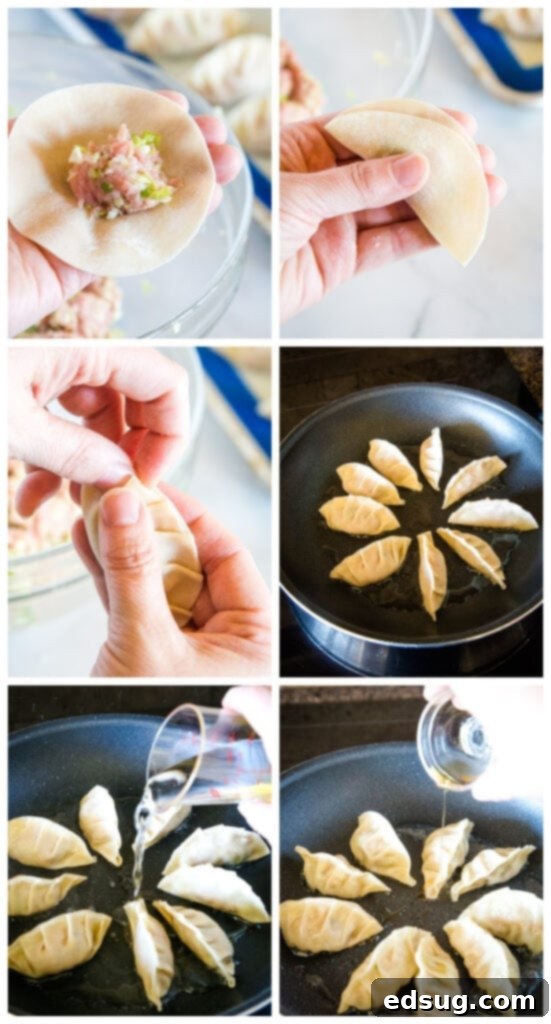
Serving Suggestions for Your Delicious Gyoza
This Gyoza recipe is a firm family favorite, and we often build an entire meal around it! For a truly authentic Japanese dining experience, serve your freshly cooked gyoza alongside a bowl of fluffy Japanese white rice. It instantly transports you back to the vibrant eateries of Japan. Beyond being a main course, gyoza also makes an excellent appetizer before a comforting bowl of Ramen, a hearty Udon soup, or a classic Egg Drop Soup.
To further enhance your meal, consider adding a light side salad with a ginger dressing or some steamed greens. The possibilities are endless when it comes to pairing these versatile dumplings. Pork, as we’ve discussed, is a universally beloved protein – satisfying, flavorful, and incredibly adaptable. It’s my absolute go-to for countless recipes due to its versatility and ease of preparation. So, whether you’re yearning for a comforting Smothered Pork Chop dinner or eager to embark on a culinary journey to another part of the world with these exquisite Gyoza, pork truly is the perfect choice to anchor your meal.
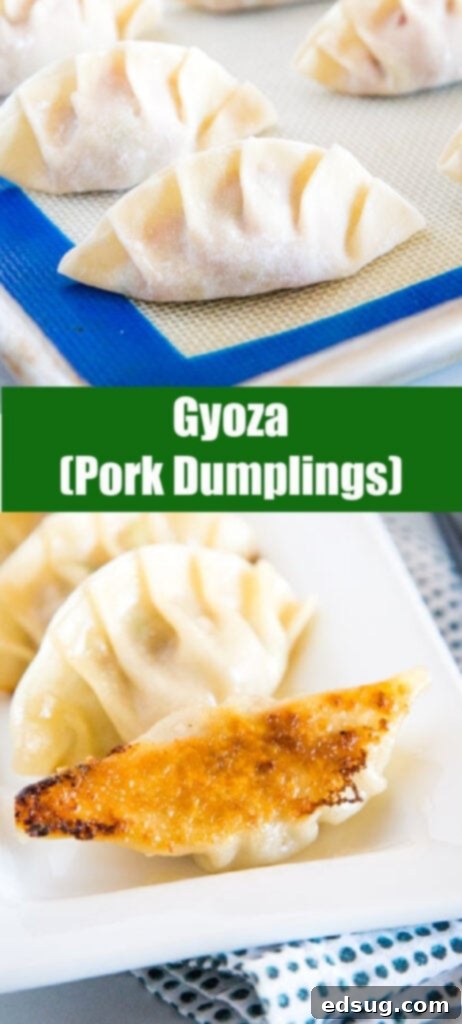
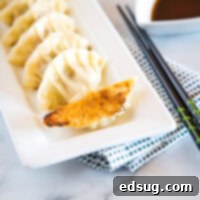
Gyoza (Japanese Pork & Vegetable Dumplings)
Erin Sellin
30
10
40
50
Rate Recipe
Print Recipe
Ingredients
- 50 Gyoza Wrappers
- 1 Tablespoon vegetable oil, per batch of gyoza
- 1/4 cup water, per batch of gyoza
- 1 teaspoon sesame oil, per batch of gyoza
Gyoza Filling
- 3/4 pound ground pork
- 2 1/2 cups finely chopped cabbage
- 1/4 cup finely chopped green onions
- 1 clove garlic, minced
- 1 inch piece of ginger, minced
- 1 Tablespoon sake
- 1 Tablespoon sesame oil
- 1 teaspoon soy sauce
- 1/2 teaspoon salt
- 1/4 teaspoon black pepper
Dipping Sauce
- 2 Tablespoon soy sauce
- 2 Tablespoon rice vinegar
Instructions
-
In a large bowl, thoroughly mix together all of the ingredients for the gyoza filling until well blended and cohesive.
To Fill & Fold Dumplings
-
Place a small amount of filling (about 2 teaspoons) into the center of a gyoza wrapper.

-
Dip your finger in water and moisten the outer 1/4 inch of the wrapper all the way around the edge. This helps in sealing.
-
While holding the wrapper, fold it in half over the filling to create a crescent shape. Then, starting at one edge, use your thumb and forefinger to make small pleats, approximately 1/4 inch apart, along the top edge of one side of the dumpling.

-
After making each pleat, gently press down to seal the dough together, moving onto the next one. You should end up with about 6 pleats from one end to the other.

-
Place the completed dumpling on a lined baking sheet, gently pressing down to flatten its bottom. This flat base is key for achieving a crispy crust during cooking.

To Cook Dumplings
-
Heat 1 tablespoon of vegetable oil in a large non-stick skillet over medium-high heat. Once the oil is hot, carefully arrange a single layer of dumplings in the pan, ensuring they don’t touch. Depending on your pan size, you can typically fit 8-12 gyoza per batch.
-
Cook for approximately 3 minutes, or until the bottoms of the gyoza turn a beautiful golden brown and become crispy.
-
Carefully pour 1/4 cup of water into the pan, then immediately cover it with a lid to steam the dumplings. Continue steaming for 3-4 minutes, or until all the water has evaporated and the filling is cooked through.
-
Remove the lid, then drizzle 1 teaspoon of sesame oil around the edges of the pan. Cook for an additional 2-3 minutes, uncovered, to ensure the bottoms become extra golden and delightfully crispy.
-
Remove the cooked gyoza from the pan and serve immediately with your dipping sauce.
To Make Dipping Sauce
-
In a small bowl, simply whisk together the soy sauce and rice vinegar until well combined. For an optional spicy kick, add a dash of chili oil.
Nutrition
Calories: 49kcal |
Carbohydrates: 5g |
Protein: 2g |
Fat: 2g |
Saturated Fat: 1g |
Polyunsaturated Fat: 1g |
Cholesterol: 6mg |
Sodium: 96mg
Nutrition information is automatically calculated, so should only be used as an approximation.
Additional Info
Erin Sellin
30
10
40
Appetizer Recipes
Japanese
50
49
Like this recipe? Leave a comment below!
I’ve created a fun and engaging community on Facebook, and I would absolutely love for you to join us! It’s a vibrant space where you can share your favorite recipes, ask questions, exchange culinary tips, and stay updated on all the new and exciting recipes from Dinners, Dishes and Desserts (so you never miss out!).
Be sure to follow me on Instagram and tag #dinnersdishes so I can see all the wonderful DINNERS, DISHES, AND DESSERTS recipes YOU create!
Don’t forget to follow me on my social media channels, so you never miss a post or a new delicious recipe!
Facebook | Twitter | Pinterest | Instagram
